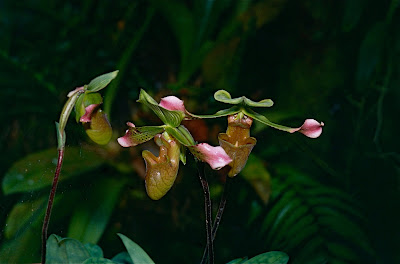Paphiopedilum bullenianum occurs in Sulawesi, Sumatra, Peninsular Malaysia and Borneo. It grows as a terrestrial herb in a variety of habitats: in moss and leaf litter on the still-roots of mangroves, in leaf litter on steep slopes, wet moss covered rocks in shade of forest and it grows as a lithophyte on moss covered boulders at elevations of sea level to 1850 meters.
Paphiopedilum bullenianum also called as Bullen's Paphiopedilum, Cordula amablis, Cordula bulleniana, Cypripedium bullenianum, Cypripedium hookerae var amabile, Cypripedium hookerae var bullenianum, Cypripedium robinsonii, Paphiopedilum amabile, Paphiopedilum bullenianum var celebensis, Paphiopedilum bullenianum var. johorense, Paphiopedilum celebesensis, Paphiopedilum ceramensis, Paphiopedilum hookerae var bullenianum, Paphiopedilum johorensis, Paphiopedilum linii, Paphiopedilum robinsonii, Paphiopedilum tortipetalum, Paphiopedilum tortisepalum, is a species of the genus Paphiopedilum. This species was described by Ernst Hugo Heinrich Pfitzer in 1894.
IDENTIFY PAPHIOPEDILUM BULLENIANUM ORCHID PLANT
Paphiopedilum bullenianum occurs in Sulawesi, Sumatra, Peninsular Malaysia and Borneo. It grows as a terrestrial herb in a variety of habitats: in moss and leaf litter on the still-roots of mangroves, in leaf litter on steep slopes, wet moss covered rocks in shade of forest and it grows as a lithophyte on moss covered boulders at elevations of sea level to 1850 meters.
It is a medium sized, hot to cool growing, terrestrial species with elliptic to narrowly elliptic, indistinct mottled darker green on bluish green leaves.
Bullen's Paphiopedilum blooms in the winter and spring on an erect, 30 cm long, generally single flowered, purple pubescent with purple spotted scape and a ciliate bract holding the flower well above the leaves.
PAPHIOPEDILUM BULLENIANUM ORCHID PLANT CARE AND CULTURE
Cultural information should only be used as a guide, and should be to be adapted to suit you. Your physical location; where you grow your plants, how much time you have to devote to their care, and many other factors, will need to be taken into account. Only then can you decide on the cultural methods that best suit you and your plants.
Light:
Paphiopedilum bullenianum like bright sunshine without access to direct sunlight, so during the midday solstice they must be placed behind a curtain or in the shade of other plants.
Temperature:
This orchid need the follow temperature regime: day temperature at 20-25 ° C with night reduction to 16-22 ° C. For successful cultivation at home, the night temperature of the content should always be 3 ° C lower than the daily one.
Humidity:
The humidity of 50-70% will be enough for normal growth and development of the plant. However, at temperatures above 27 ° C, it is desirable to increase the air humidity to at least 70%, since too dry air adversely affects the roots and leaves of the plant. A lot of fresh air and sufficient air circulation are recommended.
Substrate, growing media and repotting:
Paphiopedilum bullenianum are grow only in the pot. A mixture of bark of coniferous trees with peat is best suited as a substrate. In addition, it is strongly recommended to add lime to the substrate. Practically not exhausted source of lime are seashells, which can be thoroughly washed from salt, crushed and poured into the substrate.
Repot is necessary annually. The best time for this is spring - the beginning of a new growth. A very important point here is the height of planting. If this orchid is planted incorrectly, for example, too high, the orchid's roots will hang in the air and stop growing. The substrate should cover the upper red-and-white part of the plant for 1-2 fingers, and in no case should it be tamped down, because if the substrate is too dense, the orchid can simply suffocate. When planting, you must take care of a thick layer of drainage to protect the orchid from stagnant water inside the pot.
Watering:
Bullen's Paphiopedilum needs frequent and abundant watering throughout the year. Excess water during irrigation should flow freely from the pot, since stagnation of water both inside the pot and in its pan can very quickly lead to rotting of the roots and the lower part of the plant. The substrate between waterings should dry well, but not dry completely. After watering, water from the leaves must be removed with a tissue or tissue.
Spraying the outer part of the plant at home will not lead to anything good, since the structure of its leaves resembles a funnel, and water constantly accumulates in the core of the plant, which can very quickly lead to rotting of both peduncles and the core itself.
Fertilizer:
Throughout the year, this orchid is fertilized once every two weeks in the spring and summer, once every 4 weeks in the fall and winter. Fertilizer should be applied to the plant with 30-10-10 fertilizer, diluted, ¼ teaspoon per week in summer and once a month in winter. Each month to flush the water once to prevent the salt from standing in the pot.
Rest period:
Paphiopedilum bullenianum needs a well-defined dormant period to stimulating flowering. It begins, as a rule, in the middle of November, and consists in the fact that orchids are much drier and colder than usual and not fertilized. Night temperature during this period should be no more than 15 ° C. Watering should be replaced with a light, clear spraying of the substrate. After the appearance of peduncles, the dormant period ends: watering is resumed in the usual volume, and the total temperature of the content rises.















COMMENTS